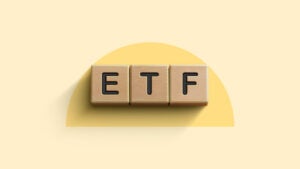Best technology ETFs

The technology sector moves quickly, so if you’re looking to invest here, it could make sense to buy a tech exchange-traded fund (ETF). A tech ETF is an easy way to build a tech portfolio, letting you play the sector if you think it’s going to run higher – and you can do it without analyzing the individual companies. An ETF also provides diversification, reducing your risk compared to buying a few individual stocks.
Here are some of the best tech ETFs to consider for your investment portfolio, with data as of April 23, 2025.
What are the main kinds of tech ETFs?
The tech sector is large, and for purposes of classification, it’s called “information technology” as part of the GICS classification system. That system breaks the tech sector down into three major industry groups:
- Software and services — This industry group includes software companies and IT services companies.
- Technology hardware and equipment — This group includes three main areas: communications equipment; technology hardware, storage and peripherals; and electronic equipment, instruments and components.
- Semiconductors and semiconductor equipment — This group includes the “chip” companies that make semiconductors and those that produce supporting equipment.
If you’re looking for broad exposure to tech, you can find funds that invest across the sector, giving you a diversified cross-section of players.
Best tech ETFs
1. Best software & services ETF
iShares Expanded Tech-Software Sector ETF (IGV)
This ETF tracks an index composed of North American software companies and interactive media companies. Top holdings include Oracle, Microsoft and Salesforce.
- 5-year returns (annualized): 14.2 percent
- Expense ratio: 0.41 percent
- Dividend yield: n/a
2. Best internet ETF
First Trust Dow Jones Internet ETF (FDN)
This ETF aims to match the investment results of the Dow Jones Internet Composite Index, which tracks stocks of U.S. internet companies. Its largest holdings include Meta Platforms, Amazon and Netflix.
- 5-year returns (annualized): 9.2 percent
- Expense ratio: 0.51 percent
- Dividend yield: n/a
3. Best semiconductor ETF
iShares Semiconductor ETF (SOXX)
This ETF tracks an index composed of U.S.-listed stocks in the semiconductor industry. Its top holdings include Broadcom, Nvidia and Texas Instruments.
- 5-year returns (annualized): 19.1 percent
- Expense ratio: 0.35 percent
- Dividend yield: 0.8 percent
4. Best diversified tech ETF
Vanguard Information Technology ETF (VGT)
This ETF tracks a benchmark index of the information technology sector, giving investors a diversified cross-section of the sector. Top holdings include Apple, Nvidia and Microsoft.
- 5-year returns (annualized): 18.6 percent
- Expense ratio: 0.09 percent
- Dividend yield: 0.6 percent
What to look for in an ETF
When investing in ETFs, it’s useful to look at a few aspects of each ETF so that you actually buy what you think you’re buying. Here are three key things to look for:
- The sub-sector — Each sub-sector may respond differently to developments in the industry. For example, software companies will respond differently to growing demand than semiconductor companies, which often have to deal with the cyclicality of that sub-sector. So you need to know what kinds of companies your ETF owns.
- The investment track record — The track record of the ETF can give you an indication of how the fund might perform in the future, though there are no guarantees. Has the ETF outperformed or underperformed the industry? The sub-sector can heavily influence the track record, since not all tech sub-sectors perform the same.
- The expense ratio — Pay attention to the expense ratio, which tells you how much it costs to own the fund annually as a percent of your total investment in it.
Finally, it’s worth noting that larger ETFs tend to charge lower expense ratios, because they can spread the costs of running the fund across more assets. So the cheapest funds may often be the largest funds, and a low expense ratio is a key measure of what makes a top ETF.
How to invest in tech ETFs
An ETF can make it easier for individual investors to invest in the tech sector, but because of the various industry dynamics at play, you’ll still need to know some of the sub-sectors you’re investing in. While some sectors do well almost perennially, others may be more cyclical and have more booms and busts, depending on their specific dynamics.
The ETFs above give you a highly liquid way to invest in the tech sector, but you’ll want to carefully consider which sectors you’re investing in. If you want to invest in an upswing of the notoriously cyclical semiconductor industry, you may want a fund that’s focused exclusively on that industry group. If you’re right, you may enjoy even greater profits than you would earn with a more broadly diversified tech ETF.
Similarly, you may want to invest in one of the most profitable areas of the market – software companies. The big appeal of software is that these firms can operate with enormous margins as they grow their sales. Because the incremental costs on software sales are low, much of every incremental dollar of sales may add to pre-tax profit.
Bottom line
Investors looking for exposure to the tech sector have a few different options to play it, from funds that invest in sub-sectors to those that invest across the sector. So it’s important to know which sector you’re investing in and the potential risks and returns offered by each ETF. For this reason, some investors stick to broadly diversified index funds, such as those based on the Standard & Poor’s 500 index, and don’t worry too much about a sector’s ups and downs.
— Bankrate’s Brian Baker contributed to an update of this story.
Editorial Disclaimer: All investors are advised to conduct their own independent research into investment strategies before making an investment decision. In addition, investors are advised that past investment product performance is no guarantee of future price appreciation.
Why we ask for feedback Your feedback helps us improve our content and services. It takes less than a minute to complete.
Your responses are anonymous and will only be used for improving our website.






